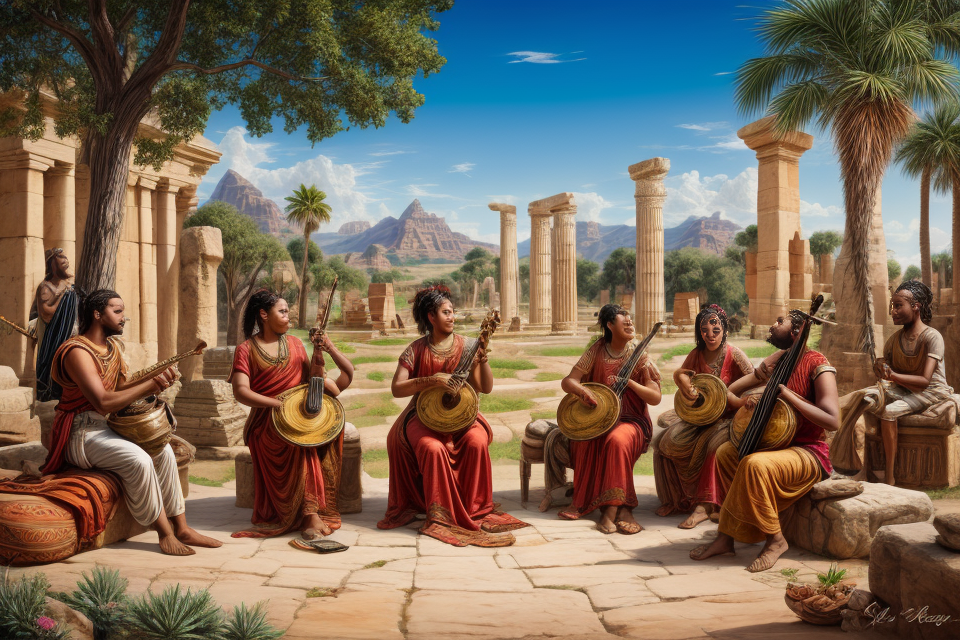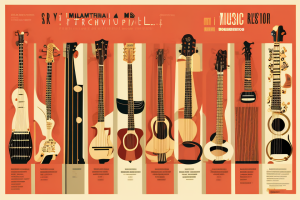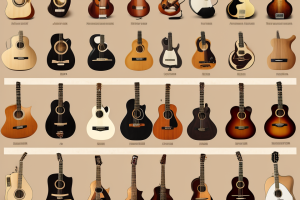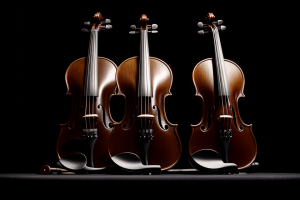
The origin of instrumental music is a topic that has fascinated music enthusiasts for centuries. It is a journey that takes us back in time, to the ancient civilizations that used musical instruments to express themselves and celebrate life’s milestones. From the bone flute of the Paleolithic era to the sophisticated stringed instruments of the Middle Ages, the evolution of instrumental music is a testament to the ingenuity and creativity of humankind. Join us as we explore the origins of this beautiful art form and discover how it has shaped our world.
The origin of instrumental music can be traced back to ancient civilizations such as Egypt, Greece, and Rome, where musical instruments were used in religious ceremonies and courtly entertainment. However, the development of instrumental music as a distinct form of music that stands on its own, separate from vocal music, emerged in Europe during the 17th and 18th centuries. This was a time of great artistic and cultural flowering, marked by the rise of the symphony orchestra, the development of musical genres such as the concerto and the sonata, and the emergence of composers such as Bach, Mozart, and Beethoven. Instrumental music continued to evolve and diversify throughout the 19th and 20th centuries, encompassing a wide range of styles, techniques, and instruments, and remains an important and beloved form of music to this day.
The Emergence of Instruments in Early Societies
The Role of Musical Instruments in Ancient Cultures
In ancient cultures, musical instruments played a significant role in various aspects of life. They were used in religious ceremonies, celebrations, and as a form of entertainment. Musical instruments were also used as a means of communication and to express emotions.
Some of the earliest known musical instruments were found in the ancient civilizations of Mesopotamia, Egypt, and China. These instruments included drums, flutes, and harps, which were made from materials such as wood, bone, and shells.
The ancient Greeks and Romans also had a rich tradition of musical instruments. The Greeks used instruments such as the aulos, a reed instrument similar to a modern-day clarinet, and the lyre, a stringed instrument similar to a small harp. The Romans, on the other hand, had a variety of instruments including the cornu, a type of trumpet, and the cithara, a stringed instrument similar to a guitar.
Musical instruments were also an important part of ancient Indian culture. The veena, a stringed instrument, and the mridangam, a drum, were commonly used in religious ceremonies and as a form of entertainment.
Overall, musical instruments played a significant role in ancient cultures and were used in various aspects of life. They were used to express emotions, communicate, and entertain.
The Development of Instruments in Mesopotamia and Egypt
The history of instrumental music can be traced back to ancient civilizations such as Mesopotamia and Egypt, where instruments were first developed and used in religious and cultural ceremonies. These early instruments were often made from materials that were readily available, such as wood, bone, and metal, and were often used to accompany vocal music or to provide a musical background for rituals and dances.
In Mesopotamia, instruments such as the lyre, which consisted of a soundbox, two arms, and a crossbar, and the panflute, which was made from reeds, were popular. These instruments were used in the courts of kings and in religious ceremonies, and were often depicted in artwork and inscriptions from the time.
In Egypt, instruments such as the lute, which was similar to a guitar, and the flute, which was made from bone or wood, were also popular. These instruments were used in religious ceremonies and in the courts of pharaohs, and were often depicted in artwork and inscriptions from the time.
Overall, the development of instruments in Mesopotamia and Egypt marked the beginning of instrumental music as we know it today, and laid the foundation for the evolution of music and musical instruments in the centuries that followed.
The Evolution of Instruments in Europe
The Impact of Classical Music on Instrumental Development
The development of instrumental music in Europe was significantly influenced by the rise of classical music. Classical music, which emerged during the 18th century, placed a greater emphasis on instrumental music and marked a significant shift in the way instruments were used in music. This shift had a profound impact on the evolution of instruments and the way they were designed and played.
One of the key developments in instrumental music during the classical period was the creation of the piano. The piano, which was invented in the early 18th century, revolutionized the way instruments were played and allowed for greater expressiveness in music. The piano’s design, which incorporated a keyboard and strings, enabled players to produce a wide range of sounds and dynamics, making it an ideal instrument for the composition of classical music.
Another important development in instrumental music during the classical period was the refinement of the violin. The violin, which had been in use since the 16th century, underwent significant changes during the 18th century, including the development of the modern violin shape and the use of more advanced materials. These changes allowed for greater precision and control in playing, making the violin an essential instrument in classical music.
In addition to the development of new instruments, the classical period also saw a greater emphasis on technical skill and virtuosity in instrumental performance. Composers such as Wolfgang Amadeus Mozart and Ludwig van Beethoven wrote music that challenged instrumentalists to push the boundaries of their technical abilities, leading to a greater focus on instrumental mastery.
Overall, the impact of classical music on instrumental development in Europe was significant and far-reaching. The creation of new instruments, the refinement of existing ones, and the emphasis on technical skill and virtuosity all contributed to the evolution of instrumental music and continue to influence the way instruments are designed and played today.
The Rise of Popular Instruments in the Middle Ages
During the Middle Ages, a period that spanned from the 5th to the 15th century, instrumental music played a significant role in European society. Instruments such as the lute, harp, and fiddle became increasingly popular among the upper and middle classes, as they were considered a symbol of status and sophistication.
One of the most significant factors that contributed to the rise of popular instruments in the Middle Ages was the growing influence of the Church. As Christianity spread throughout Europe, the Church began to incorporate music into its liturgical practices. This led to the development of a new class of musicians known as “organists,” who were responsible for playing the organ during religious services.
In addition to the organ, other instruments such as the lute and harp became popular among the upper classes. These instruments were often used in courtly settings, where they were played during banquets and other social events. The lute, in particular, became a favorite of the aristocracy, as it was small enough to be carried around and played in various settings.
As instrumental music continued to gain popularity, a new class of professional musicians emerged. These musicians were known as “minstrels,” and they traveled from town to town, performing for various audiences. Minstrels were skilled instrumentalists who played a variety of instruments, including the lute, harp, and fiddle. They were also known for their ability to compose original music and to improvise on existing melodies.
Despite the growing popularity of instrumental music in the Middle Ages, it was still considered secondary to vocal music. The Church, in particular, placed a strong emphasis on the importance of singing in religious services, and instrumental music was often viewed as a form of entertainment rather than a serious art form. Nevertheless, the rise of popular instruments in the Middle Ages marked an important turning point in the history of Western music, laying the foundation for the development of modern instrumental music.
The Influence of World Music on Instrumental Music
The Contribution of African and Asian Instruments to the Global Music Scene
African Instruments
African instruments have played a significant role in shaping the global music scene. The African continent is home to a diverse range of musical traditions, each with its unique instruments and musical styles.
Drums
Drums are one of the most widely used instruments in African music. They are used in various forms of music, from traditional ceremonies to modern pop music. Drums have a rich history in Africa and are often used to convey messages, tell stories, and express emotions.
Xylophone
The xylophone is another popular instrument in African music. It is commonly used in traditional music and has also been adapted for use in modern music genres. The xylophone’s distinctive sound has been featured in many popular songs, and it continues to be an important instrument in African music.
Asian Instruments
Asian instruments have also had a significant impact on the global music scene. Asian music is characterized by its unique musical traditions and the use of distinctive instruments.
Sitar
The sitar is a stringed instrument commonly used in Indian classical music. It has a distinctive shape and is played with a pick or finger. The sitar’s melodic sound has been featured in many popular songs and has had a significant influence on the development of Western music.
Gamelan
Gamelan is a type of ensemble music that originated in Indonesia. It is characterized by its use of percussion instruments and metallophones, which create a distinctive sound. Gamelan music has had a significant impact on the development of Western classical music, and its influence can be heard in many classical compositions.
In conclusion, African and Asian instruments have played a crucial role in shaping the global music scene. Their unique sounds and musical traditions have influenced the development of many musical genres, from classical music to rock and roll. Today, these instruments continue to be an important part of the music world, and their influence can be heard in music from all over the globe.
The Evolution of Latin American and Caribbean Instruments
Latin American and Caribbean music have played a significant role in shaping the evolution of instrumental music. These regions have a rich cultural heritage that has contributed to the development of various musical instruments. The following are some of the ways in which Latin American and Caribbean instruments have evolved over time.
The Role of Indigenous Peoples
Indigenous peoples of Latin America and the Caribbean have contributed significantly to the evolution of musical instruments. Their cultures have unique musical traditions that have influenced the development of various instruments. For example, the Andean region of South America has a long history of flute-making. The flute is an essential instrument in many Andean cultures, and it has been used for centuries to express religious and cultural beliefs.
African Influence
African slaves were brought to Latin America and the Caribbean during the colonial period. They brought with them their musical traditions, which influenced the development of various instruments. For example, the African instrument known as the banjo evolved into the modern-day steel drum in the Caribbean. The steel drum is now a symbol of Caribbean music and culture.
European Influence
European influence also played a significant role in the evolution of Latin American and Caribbean instruments. European colonizers introduced new instruments such as the guitar, violin, and piano to the region. These instruments were then adapted to fit the local musical traditions, resulting in the development of new and unique instrumental sounds.
Syncretism
Syncretism is the blending of different cultural traditions. In the case of Latin American and Caribbean music, syncretism has led to the development of unique musical instruments. For example, the cajón, a Peruvian instrument, is a box drum that was originally used in the Andean region. It has since been adapted and is now played in various genres of music throughout the world.
In conclusion, the evolution of Latin American and Caribbean instruments has been influenced by a variety of factors, including indigenous peoples, African slaves, European colonizers, and syncretism. These influences have resulted in the development of unique and diverse instrumental sounds that are an essential part of world music.
The Technological Advancements in Instrument Design
The Invention of the Piano and Its Impact on Instrumental Music
The invention of the piano is considered a pivotal moment in the history of instrumental music. The piano was invented in the early 1700s by Bartolomeo Cristofori, an Italian instrument maker. It was initially called the “pianoforte,” which translates to “soft-loud” in Italian, reflecting the instrument’s unique ability to produce both soft and loud sounds.
The piano quickly gained popularity among composers and musicians due to its versatility and expressiveness. It allowed for a wider range of dynamics and tone colors than previous keyboard instruments, such as the harpsichord. This made it possible to convey a greater range of emotions and musical ideas in compositions.
One of the most significant aspects of the piano’s design is its keyboard, which features a combination of black and white keys. The black keys are arranged in groups of two and three, while the white keys are arranged in a pattern of alternating black and white. This design allows for the production of a wide range of pitches and notes, making it a highly versatile instrument for composers and performers.
The piano’s impact on instrumental music cannot be overstated. It became the central instrument in classical music, and its influence can be heard in the works of many famous composers, including Wolfgang Amadeus Mozart, Ludwig van Beethoven, and Frederic Chopin. The piano’s expressive capabilities also influenced the development of other instrumental genres, such as jazz and popular music.
Today, the piano remains an essential instrument in classical music and is widely used in a variety of musical styles. Its enduring popularity and significance are a testament to the ingenuity of its inventor and the lasting impact it has had on the world of music.
The Development of Electronic Instruments in the 20th Century
Introduction
Electronic instruments have been a significant part of the development of instrumental music in the 20th century. These instruments utilize electronic circuits and devices to produce sound, and they have revolutionized the way that musicians create and perform music. In this section, we will explore the history of electronic instruments and their impact on the music industry.
Early Electronic Instruments
The earliest electronic instruments were developed in the early 20th century, including the theremin, which was invented in 1919 by Leon Theremin. This instrument used a radio frequency oscillator to produce a sound, and it was played by moving the performer’s hands near the instrument. Other early electronic instruments included the trautonium, which was developed in Germany in the 1920s, and the Ondes Martenot, which was developed in France in the 1930s.
The Development of Synthesizers
The development of synthesizers in the 1960s and 1970s marked a significant turning point in the history of electronic instruments. Synthesizers allowed musicians to create a wide range of sounds, including electronic tones, imitations of acoustic instruments, and even natural sounds such as animal noises or weather effects. The first commercial synthesizer was the RCA Mark II, which was released in 1957. However, it was the development of the Moog synthesizer in the 1960s that truly revolutionized the industry.
The Impact of Electronic Instruments on Music
Electronic instruments have had a profound impact on the music industry, allowing musicians to create new sounds and experiment with different musical styles. Electronic instruments have been used in a wide range of genres, including rock, pop, jazz, and classical music. They have also been used in film and television scores, video game soundtracks, and other forms of multimedia.
Conclusion
In conclusion, the development of electronic instruments in the 20th century has had a significant impact on the music industry. These instruments have allowed musicians to create new sounds and experiment with different musical styles, and they have played a crucial role in the evolution of instrumental music.
The Role of Instrumental Music in Modern Society
The Popularity of Instrumental Music in the 21st Century
The Evolution of Instrumental Music in the 21st Century
In the 21st century, instrumental music has experienced a significant evolution, becoming more diverse and accessible to a wider audience. The emergence of various sub-genres, including electronic, ambient, and experimental music, has expanded the possibilities of instrumental music, making it more appealing to different listeners. Additionally, the rise of online platforms and digital distribution has allowed artists to reach a global audience, increasing the popularity of instrumental music worldwide.
The Influence of Technology on Instrumental Music
Technological advancements have played a crucial role in the popularity of instrumental music in the 21st century. The development of digital audio workstations (DAWs) and music production software has enabled artists to produce and record their music with high-quality sound. Furthermore, the accessibility of these tools has allowed a new generation of musicians to emerge, experimenting with different styles and techniques, and contributing to the growth of instrumental music.
The Impact of Social Media on Instrumental Music
Social media platforms, such as YouTube, Spotify, and SoundCloud, have significantly impacted the popularity of instrumental music in the 21st century. These platforms have provided a space for artists to share their music with a global audience, gaining exposure and building a fan base. Additionally, social media has enabled listeners to discover new music and share their favorite instrumental tracks with others, contributing to the growth of the genre.
The Relevance of Instrumental Music in Modern Society
In modern society, instrumental music has become a relevant form of expression, transcending language barriers and resonating with people from different cultures. Its versatility and adaptability make it an ideal choice for various contexts, including film and television soundtracks, video games, and background music in public spaces. Moreover, the growing interest in instrumental music reflects a desire for introspection and contemplation, as it offers a unique sonic experience that can evoke emotions and create atmospheres without the constraints of lyrics.
Overall, the popularity of instrumental music in the 21st century is a testament to its ability to evolve and adapt to changing times, resonating with listeners on a deeper level and solidifying its position as a vital aspect of modern music culture.
The Future of Instrumental Music and Its Continued Evolution
As technology continues to advance and the world becomes more interconnected, the future of instrumental music is bright. Here are some potential developments to look out for:
Virtual and Augmented Reality
One of the most exciting possibilities for the future of instrumental music is the integration of virtual and augmented reality technology. With VR and AR, musicians and audiences can experience music in entirely new ways. For example, a virtual reality concert could allow audiences to feel like they are actually in the same room as the performers, while an augmented reality app could provide interactive visualizations of the music as it is being played.
Increased Accessibility
Another potential development for the future of instrumental music is increased accessibility. With the rise of streaming services and social media, more people than ever have access to high-quality music. This trend is likely to continue, with new technologies making it easier for people to discover and enjoy instrumental music from all over the world.
Cross-Cultural Collaboration
As instrumental music becomes more popular and accessible, we can also expect to see more cross-cultural collaboration. Musicians from different parts of the world will have more opportunities to work together and share their unique styles and traditions. This could lead to the creation of entirely new genres of music, as well as a greater appreciation for the diversity of instrumental music around the world.
New Instruments and Technologies
Finally, we can expect to see the continued evolution of new instruments and technologies. From the electric guitar to the synthesizer, instrumental music has always been shaped by new technologies and innovations. In the future, we can expect to see even more new instruments and technologies that will push the boundaries of what is possible in instrumental music.
Instrumental Music: A Universal Language
The Power of Instrumental Music to Transcend Cultural Boundaries
Instrumental music has been a powerful tool for transcending cultural boundaries, connecting people across the globe and allowing them to communicate and relate to one another through the universal language of music. The ability of instrumental music to cross cultural barriers is due to its abstract nature, which allows it to convey emotions and ideas without the need for language.
One of the main reasons why instrumental music is able to transcend cultural boundaries is that it is not tied to any specific language or dialect. Unlike spoken language, instrumental music does not rely on words or syntax to convey meaning. Instead, it uses melody, rhythm, and harmony to create a universal language that can be understood by people from any culture.
Another reason why instrumental music is able to transcend cultural boundaries is that it has the power to evoke emotions and memories in listeners. Music has the ability to tap into the deepest parts of the human psyche, triggering memories and emotions that are common to all people, regardless of their cultural background. This shared emotional experience can create a strong bond between people, even if they come from very different cultures.
Additionally, instrumental music has been used throughout history as a tool for diplomacy and cultural exchange. Musicians have traveled across borders and oceans to perform for foreign audiences, promoting understanding and goodwill between nations. Instrumental music has also been used as a means of preserving cultural heritage, with traditional instruments and musical styles being passed down from generation to generation.
In conclusion, the power of instrumental music to transcend cultural boundaries is a testament to its universal language. Through its ability to evoke emotions and memories, and its use as a tool for diplomacy and cultural exchange, instrumental music has the power to bring people together and create a shared cultural experience.
The Enduring Appeal of Instrumental Music Across the Globe
Despite the cultural and linguistic diversity that exists across the world, instrumental music has maintained a universal appeal that transcends boundaries and resonates with people of all backgrounds. This enduring appeal can be attributed to several factors, including the timelessness of melody, the versatility of instrumental music, and its ability to evoke emotions and tell stories without the constraints of language.
One of the key reasons why instrumental music has remained popular throughout history is its ability to convey emotion and tell a story without the need for words. In many cultures, instrumental music has been used to express feelings of love, sadness, joy, and other emotions that are universal and transcend language barriers. For example, the haunting melodies of a violin can convey a sense of longing and sorrow, while the upbeat rhythms of a jazz band can evoke feelings of joy and celebration.
Another factor that contributes to the enduring appeal of instrumental music is its versatility. Instrumental music can be adapted to suit a wide range of settings and occasions, from intimate performances in small venues to grand spectacles in large arenas. Additionally, instrumental music can be combined with other art forms, such as dance and theater, to create multimedia performances that engage and captivate audiences.
Furthermore, the global popularity of instrumental music can be attributed to the skill and craftsmanship of the musicians who create it. From classical concertos to jazz improvisations, instrumental music requires a high level of technical proficiency and artistic creativity. Musicians who specialize in instrumental music must be able to convey emotion and tell a story through their playing, while also demonstrating their mastery of their chosen instrument.
In conclusion, the enduring appeal of instrumental music across the globe can be attributed to its timelessness, versatility, and the skill and craftsmanship of the musicians who create it. Whether played in a small jazz club or a grand concert hall, instrumental music has the power to transcend language barriers and connect people from all walks of life.
FAQs
1. What is instrumental music?
Instrumental music is a form of music that is performed without any vocals or lyrics. It is typically composed for a solo instrument or a group of instruments, such as an orchestra or a band. The instrumental music can include a wide range of genres, from classical to jazz, and from rock to pop.
2. What is the origin of instrumental music?
The origin of instrumental music can be traced back to ancient civilizations such as Egypt, Greece, and Rome. In these cultures, music was often used in religious ceremonies and was performed using a variety of instruments, including harps, lyres, and flutes. As time passed, instrumental music evolved and became more sophisticated, with new instruments being developed and new styles of music emerging.
3. When did instrumental music become popular?
Instrumental music has been popular for thousands of years, but it experienced a surge in popularity during the Classical period, which began in the late 18th century. During this time, composers such as Wolfgang Amadeus Mozart and Ludwig van Beethoven wrote many famous instrumental pieces, including symphonies and concertos. In the 20th century, instrumental music continued to evolve and became a key part of many popular music genres, including jazz, rock, and pop.
4. What are some examples of instrumental music?
There are many examples of instrumental music, including classical pieces such as Beethoven’s “Symphony No. 5” and Mozart’s “Eine kleine Nachtmusik,” as well as popular songs such as The Beatles’ “All You Need Is Love” and Led Zeppelin’s “Stairway to Heaven.” Other examples include jazz standards like Miles Davis’ “So What” and Charlie Parker’s “Confirmation,” and modern pop instrumentals like The xx’s “On Hold” and The Chemical Brothers’ “Go.”
5. What are the different types of instrumental music?
There are many different types of instrumental music, including classical music, jazz, rock, pop, electronic, and experimental. Within each of these genres, there are further subgenres and styles, such as baroque, romantic, and avant-garde in classical music, and fusion, free jazz, and experimental in jazz.







